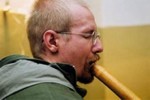Shakuhachi and Zen-Buddhism
Shakuhachi playing can be mainly divided into three classical styles: Meian-ryu, Kinko-ryu ja Tozan-ryu. The latter two are highly refined musical styles and bear the names of the founders of respective schools: Kinko Kurosawa (1710-1771) and Nakao Tozan (1876-1956). Meian-ryu is the oldest school of shakuhachi playing and is inseparable from the original doctrine of ?blowing Zen'. Also being called ?Fuke sect'after its founder, it is a school of Zen-Buddhism which resorts to shakuhachi playing instead of reading sutras in order to achieve Enlightenment (satori). ?Itton Jobutsu' - Buddha is hidden in one sound - is one of the sayings of Fuke monks or Komuso (?the monks of emptiness'). They revered shakuhachi as a ritual instrument that was allowed to be used only in religious contexts. The meaning of ?Komuso' itself is probably derived from a large basket-like hat (tengai), which they used to cover their faces symbolising humility and anonymity, and to emphasise the profound difference between two worlds. For Fuke monks shakuhachi playing was closely related to spiritual and ritual practice, which took up the greater part of their everyday activities. For instance, the day started with a piece called Kakuseirei, a waking call for monks. Then the monks gathered before the altar and played the next piece, Choka, to start the daily monastery service. During the day monks practiced both suizen and the martial arts. Banka was the piece reserved for the evenings and other night-time esoteric practices involved the pieces of Shin-ya and Reibo. In addition every monk had the obligation to go on a three-day trip to collect charities every month. The obligatory repertoire of mendicant monks included such pieces as the Tori (Passing), Kadozuke (Street Corners) and Hachigaeshi (Return the Bowl). When two Komuso monks met during their journeys, they used to play Yobi Take (The Call of shakuhachi) and Uke Take (The Answer of shakuhachi). When a monk became weary of travelling and he desired to rest for a while in a Komuso temple, he played Hirakimon or Monbiraki (Open the Gates) to gain the permission to enter. This etiquette would differ a little between various temples, but generally remained the same.Pieces which were played by the Komuso are called Honkyoku. These are solo pieces where rhythm and phrasing depends entirely on the player. Meian-ryu shakuhachi also differs significantly from modern shakuhachi. A modern instrument is covered inside with a thick coat of varnish in order to achieve precise tuning and sound volume and can be divided in two parts in the middle. The insides of older shakuhachis were left untouched and as natural as possible. The sound of such instruments was particularly etheric and rich in harmonics, and there are only few masters in Japan who can make them. The playing technique of the instrument is rather complicated. It has only five holes, which means that they often have to be covered partially and the pitch can also be varied by subtly changing the blowing angle.
Tokuyama Takashi received a degree in shakuhachi performance from Tokyo Fine Arts University. He also has a degree from Keio University in philosophy and art.
At the age of 20, he first heard Zen shakuhachi and from that moment decided to preserve this tradition as his life's work. Tokuyama has been studying and teaching Zen shakuhachi for over 30 years. In his travels, he has discovered more than 200 of these unique music treasures from all over Japan. A few old Zen priests kept many of these pieces alive although most of them have since passed away. Thanks to his efforts, these pieces have come down through the ages to us. Tokuyama Takashi has been working diligently to maintain this tradition for the present and future generations.
 Roland Suits
Roland Suits



